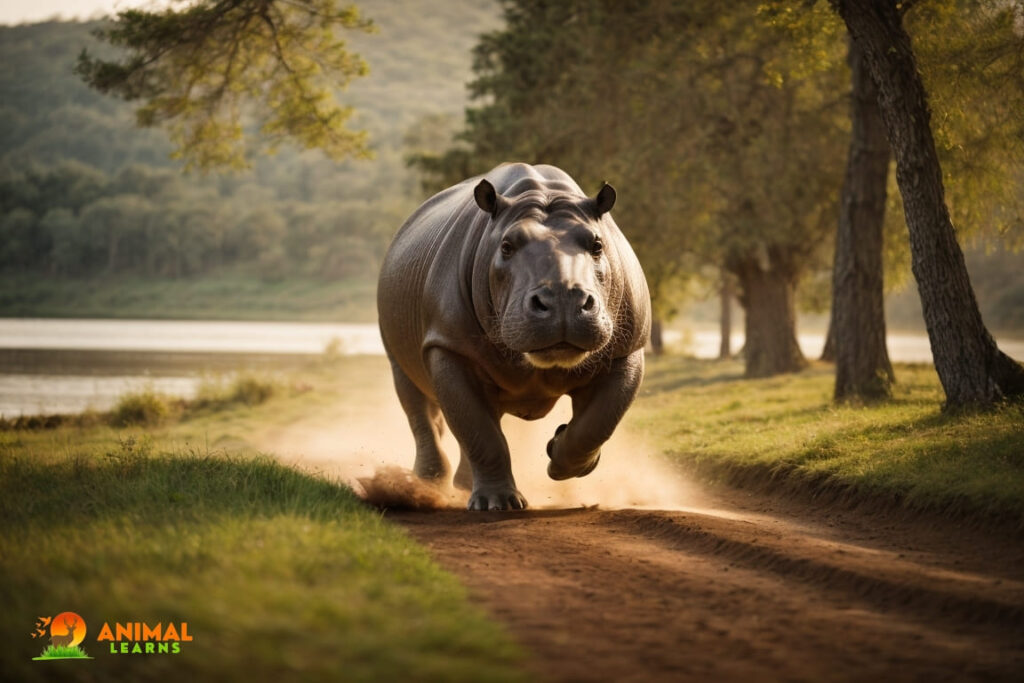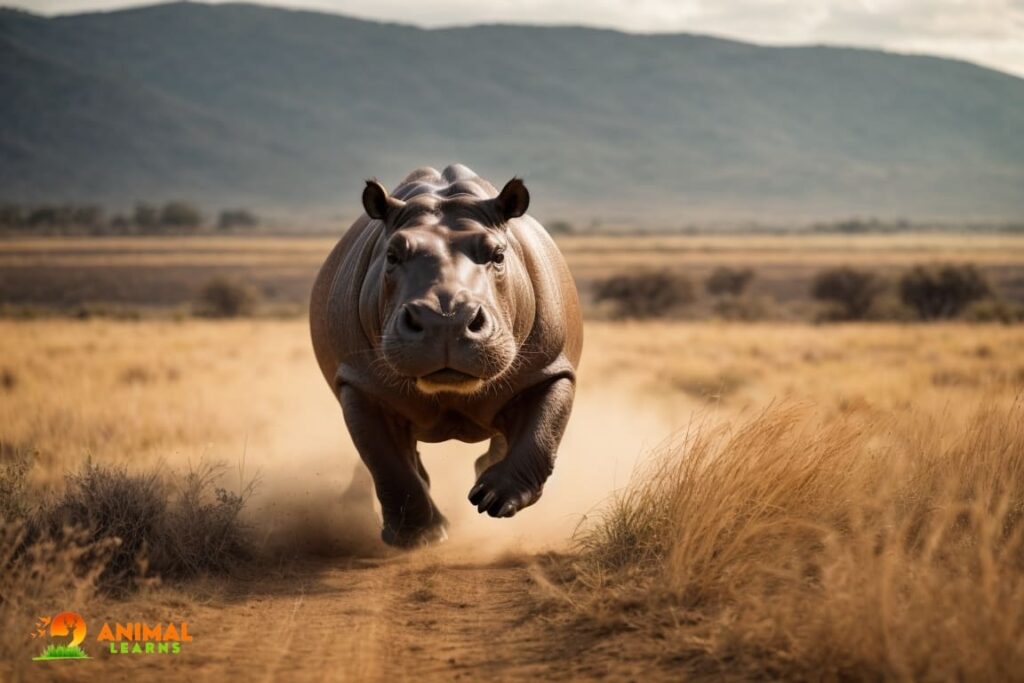Hippo Top Speed: Exploring Their Impressive Top Speed

| Attribute | Information |
|---|---|
| Size | Large |
| Weight | 1,500 to 4,000 kilograms (adults) |
| Running Speed | Up to 30 miles per hour (on land) |
| Grouping Behavior | Mostly solitary, but can form groups (pods) of up to 40 individuals |
| Habitat | Sub-Saharan Africa |
| Range | Rivers, lakes, and swamps |
| Diet | Herbivorous, mostly graze on grasses |
| Lifespan | Approximately 40-50 years (in the wild) |
| Conservation Status | Vulnerable (population declining due to habitat loss and poaching) |
The hippo top speed of 30 kilometers per hour is a testament to its surprising agility and defies common perceptions of these hefty creatures.
Hippos may be undervalued when it comes to speed, yet they contain multiple amazing attributes that set them ahead of other kinds of animals.
Can you imagine a hippo running on land like a beast or swimming in water like a fish? This article discusses why hippos are so quick and powerful, as well as the fast they can run and swim.
The secrets behind their speed and how it aids in their ability to survive in the wild will astound you. Learn more about these massive, gentle giants by diving into the world of hippos.
Understanding Hippo Speed
Contents
- 1 Understanding Hippo Speed
- 2 On Land: The Hippo’s Terrestrial Dash
- 3 In Water: The Surprising Speed of Hippos
- 4 The Adaptations That Make Hippos Fast Swimmers
- 5 How Hippos Compare to Other Aquatic Creatures
- 6 The Myth of the Fastest Hippo
- 7 Hippos vs. Other Animals
- 8 Human Fascination with Hippo Speed
- 9 The Secrets Behind Hippo Speed
- 10 FAQs
Define the concept of a hippo top-speed
One of the largest and most powerful plant-eating animals on the earth is the hippo. Where the hippo is on land or in water will influence the solution. While hippopotamuses are exceptionally quick swimmers, they are considerably faster on land.
Hippos are amazingly suitable to their environments, and by analyzing how fast they can run, we may learn more about how they do in the wild, how they survive, and what function they serve in ecosystems.
Explore the factors that influence a hippo’s speed, including size and environment.
- Hippos are huge animals that can move fast on land and water.
- Their speed depends on their size, adaptations, limbs, motivation, age, and health.
- They have strong muscles, buoyant bodies, thick skin, short legs, and webbed toes.
- They can run up to 30 mph (48 km/h) on flat land for short bursts.
- They can swim up to 8 mph (13 km/h) in water and stay underwater for 5 minutes.
- They are more efficient underwater with webbed toes and closed nostrils.
- They are usually calm but can be aggressive when defending themselves or their group.
- They are adaptable to different habitats across Africa.
On Land: The Hippo’s Terrestrial Dash

How Fast Can a Hippo Run on Land?
You might think that a hippo, with its huge and heavy body, is a slow and clumsy animal on land. But you’d be wrong! Hippo top speed, both on land and in water, plays a crucial role in their survival and dominance within their ecosystems.
These amazing creatures can run faster than you might imagine, reaching speeds of up to 30 mph (48 km/h) for short distances. That’s faster than most humans can run! How do they do it? And why do they need to run so fast? Let’s find out!
Why Hippos Can Run So Fast on Solid Ground
Hippos have several adaptations that help them run fast on land, despite their massive size. Here are some of them:
- Strong legs: Hippos have relatively short legs, but they are very powerful and can support their huge weight without any problem. They also have four toes on each foot, which gives them more stability and traction on the ground.
- Muscular body: Hippos have a lot of muscles in their body, especially in their back and hindquarters. These muscles help them accelerate and maneuver quickly on land. They also have a thick skin that protects them from injuries and parasites.
- Buoyant body: Hippos spend most of their time in the water, where they are buoyant and can move easily. This helps them conserve energy and reduce stress on their joints and bones. When they come out of the water, they use this stored energy to run fast on land.
- Evolutionary adaptations: Hippos have evolved to run fast on land over millions of years. They are related to whales and dolphins, which are also fast swimmers. They have inherited some of the traits that make these animals agile in the water, such as a streamlined shape and a flexible spine.
Interesting Facts About Hippos’ Land Speed
Hippos’ land speed is not only impressive but also interesting. Here are some fun facts about it:
- Hippos can run backward: Hippos are one of the few large mammals that can run both forward and backward. This gives them an advantage when they need to change direction quickly or escape from predators or rivals.
- Hippos are territorial: Hippos are very protective of their territory and will chase away any intruders that come too close. They use their land speed to defend their space and assert their dominance over other hippos or animals.
- Hippos are not the fastest animals: While hippos can run faster than most humans, they are not the fastest animals on land. Some of the animals that can outrun them include cheetahs, lions, gazelles, ostriches, and horses.
In Water: The Surprising Speed of Hippos
Top Speed of a Hippo in Water

Hippos can swim at speeds of up to 8 miles per hour (13 kilometers per hour) on average. That’s faster than most humans can run on land! But that’s not all.
When they need to, they can sprint even faster, reaching speeds of 20 miles per hour (32 kilometers per hour) in short bursts. That’s enough to outrun a car on a city street!
Why do hippos need to swim so fast? Well, there are several reasons. One is that they use their speed to escape from predators, such as lions or crocodiles, that might attack them on land or in the water.
Another is that they use their speed to defend their territory and mates from rival hippos, which can be very aggressive and territorial.
A third reason is that they use their speed to travel long distances in search of food and water, especially during the dry season when resources are scarce.
The Adaptations That Make Hippos Fast Swimmers
Hippos have several features that help them swim so fast and efficiently. Here are some of them:
- Buoyant and streamlined body: Hippos have large, barrel-shaped bodies that are buoyant and streamlined in the water. This reduces the drag and resistance that they face when moving through the water, allowing them to glide smoothly and effortlessly.
- Powerful leg muscles: Hippos have strong leg muscles, especially in their hind legs, that provide the thrust and propulsion that they need to swim fast. They use their legs to push off the bottom of the river or lake or to kick through the water like a frog.
- Webbed toes: Hippos have four toes on each foot that are webbed together like a duck’s feet. These act like natural flippers that help them steer and maneuver through the water with ease.
- Dense bones: Hippos have dense bones that help them sink and stay submerged while swimming. This gives them more control over their depth and allows them to avoid detection by predators or rivals.
How Hippos Compare to Other Aquatic Creatures
Hippos are not the fastest swimmers in the world, but they are certainly faster than many other animals that share their habitat. Here are some comparisons:
- Dolphins: Dolphins are among the fastest swimmers in the ocean, reaching speeds of up to 60 km/h (37 mph). They use their sleek bodies, powerful tails, and echolocation to navigate and hunt in the water. Hippos are no match for dolphins in terms of speed, but they have other advantages, such as their size, strength, and teeth.
- Sailfish: Sailfish are the fastest fish in the world, reaching speeds of up to 110 km/h (68 mph). They use their long, pointed bills, dorsal fins, and body shape to cut through the water like a sword. Hippos are much slower than sailfish, but they also live in different environments and have different lifestyles.
- Crocodiles: Crocodiles are the main predators of hippos in Africa, and they can swim at speeds of up to 32 km/h (20 mph). They use their long tails, webbed feet, and camouflage to ambush and attack their prey. Hippos can match or exceed crocodiles’ speed in the water, but they also have to be careful of their jaws and teeth.
The Myth of the Fastest Hippo
The Factors That Affect Hippo Speed

When it comes to understanding the natural world, one fascinating aspect to explore is the hippo top speed. Hippos are known for their impressive speed, but not all hippos can run or swim at the same pace. There are several factors that can affect their speed, such as:
- Age: Younger hippos tend to be faster than older ones, as they have more energy and agility.
- Size: Larger hippos have more weight and bulk to carry, which can slow them down. Smaller hippos can be more nimble and quick.
- Environment: Hippos can adapt to different environments, but some may be more favorable than others. For example, hippos can run faster on flat and dry land than on muddy or wet terrain. Similarly, hippos can swim faster in clear and calm water than in murky or turbulent water.
The True Top Speed of a Hippo
The top speed of a hippo is a topic of interest and debate among researchers and enthusiasts. According to various sources, hippos can run on land at speeds of up to 19-30 miles per hour (30-48 kilometers per hour), making them surprisingly fast for their size.
In the water, they can swim at speeds of around 5-8 miles per hour (8-13 kilometers per hour). These are impressive speeds, but they are not the absolute maximum that hippos can achieve.
These numbers can vary among individual hippos and may depend on the factors mentioned above. Moreover, these speeds are not sustained for long periods, as hippos can get tired easily.
The Misconceptions About Hippos’ Speed
Whether discussing ‘hippo top speed’ on land or in water, it highlights the remarkable capabilities of these animals. Despite their remarkable speed, hippos are often misunderstood and misrepresented in popular culture. Some of the common misconceptions about their speed are:
- Hippos are slow-moving creatures: This is far from the truth, as hippos can outrun many humans and animals on land and in water. They are not sluggish or lazy, but rather powerful and agile.
- Hippos are slow swimmers due to their massive size: This is also false, as hippos have adapted well to their aquatic habitats. They have webbed feet and nostrils that allow them to swim efficiently and breathe underwater. They also have a high density that helps them sink and float as they please.
- Hippos are the fastest animals in Africa: This is inaccurate, as there are many animals that can surpass hippos in speed. For example, cheetahs can run at speeds of up to 70 miles per hour (112 kilometers per hour), making them the fastest land animals in the world.
Hippos vs. Other Animals
Comparing Hippo Speed to Other Animals

| Animal Type | Land Speed (mph) | Land Speed (km/h) | Water Speed (mph) | Water Speed (km/h) |
| Hippo | Up to 30 mph | Up to 48 km/h | 5 to 8 mph | 8 to 13 km/h |
| Cheetah | 60 to 70 mph | 97 to 113 km/h | – | – |
| Lion | 60 to 70 mph | 97 to 113 km/h | – | – |
| Dolphin | – | – | Over 60 mph | Over 97 km/h |
| Sailfish | – | – | Over 60 mph | Over 97 km/h |
Explain how their bodies are adapted for speed
Hippo top speed is a topic of fascination for those curious about these animals’ abilities. Hippos have a special kind of speed that results from their unusual combination of size and agility.
Hippos, unlike many other big animals, is excellent in both land and water sprints. This adaptability is a result of their well-adapted bodies, which have strong leg muscles for speed on land and thick bones for buoyancy in the water.
Discuss scientific studies and research on hippo speed
Studies and tales give insight into the amazing speed of hippos. According to anecdotes, hippos have been known to outrun lions on land and display their agility in the water, where they excel at swimming.
On the scientific front, researchers use tracking devices to collect information about the habitats, behavior, and speed of hippos.
Human Fascination with Hippo Speed
Explore why people are intrigued by hippos’ speed
Hippos are huge animals that look like they move slowly and clumsily. But did you know that they can run faster than humans on land and swim like fish in water? This amazing fact defies our expectations and makes us curious about these incredible creatures.
We wonder how they can be so big and yet so fast, and how they can adapt to different environments with ease. Hippos’ speed is a source of fascination and admiration for us, as we discover more about these powerful and graceful animals.
The Mythical Meaning of Hippos’ Speed
Hippos are not only fast animals but also important symbols in some African cultures. The ancient Egyptians worshipped a hippo-headed goddess named Taweret, who was the guardian of mothers and children. She could run and swim fast to save her followers from danger, showing how hippos and speed were linked.
In other African stories, hippos were seen as mighty and mysterious animals that could move quickly in water and on land. These myths show how hippos’ speed has inspired awe and respect for centuries and across cultures.
The Secrets Behind Hippo Speed

The mysteries of the animal kingdom often revolve around unique features like the hippo top speed, which showcases the wonders of nature. The exceptional speed of hippos, whether on land or in water, is a result of their unique physiology and adaptation.
Their streamlined bodies and powerful muscles enable them to move swiftly through the water, making them one of the most formidable aquatic creatures. On land, their surprisingly fast pace is attributed to their muscular legs and ability to maintain balance despite their hefty build.
Understanding how hippos can achieve such speeds adds to the fascination surrounding these incredible animals and their remarkable adaptations to their natural habitats.
To Read More Articles like Tiger Top Speed and others Click on Animallearns.com
FAQs
What is a hippo’s top speed?
On land, hippos can run at speeds of up to 19 miles per hour (30 kilometers per hour).
How fast can a hippo swim?
In water, hippos can reach speeds of about 5 miles per hour (8 kilometers per hour).
Are hippos faster than humans?
Yes, hippos are faster runners than humans and can easily outrun a person on land.
What enables hippos to run so fast on land?
Hippos can run fast due to their powerful leg muscles and surprisingly agile movements despite their large size.
How does a hippo’s top speed compare to other animals?
Hippos are not among the fastest animals, but their speed is impressive for their size. They are slower than many predators but faster than most herbivores of similar size.
Can hippos maintain their top speed for long distances?
Hippos can maintain their top running speed for short bursts but are not built for endurance. They tire quickly.
Why do hippos need to be fast in water?
Speed in water helps hippos evade predators and maintain control in their aquatic habitat.
How does a hippo’s top speed contribute to its survival?
Hippos’ speed helps them escape from danger, defend their territory, and protect their young, making it a crucial aspect of their survival strategy.












